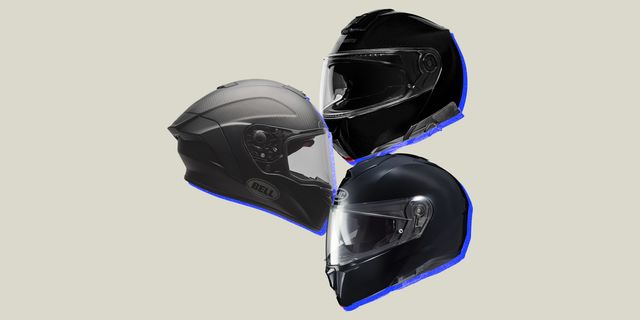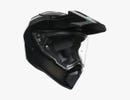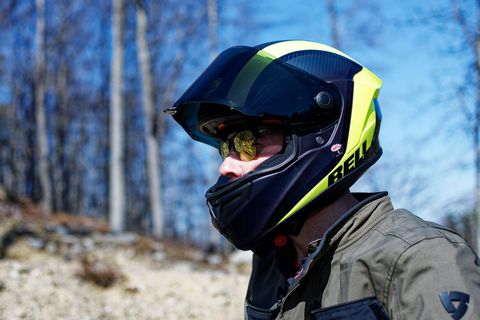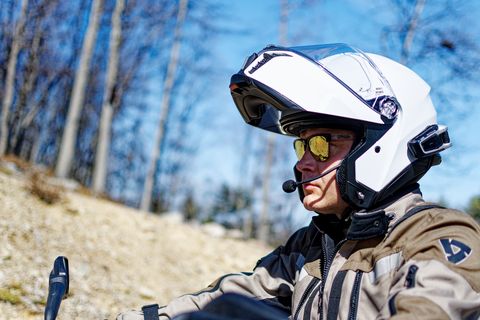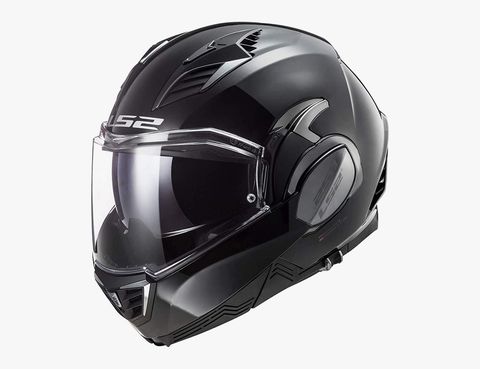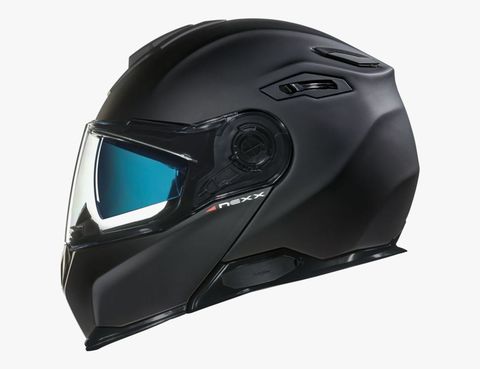A Bluetooth-equipped helmet can be an essential piece of motorcycle safety tech, whether you're staying in touch with your posse or getting turn-by-turn directions from a paired phone. But the term Bluetooth helmet technically can be a bit of a misnomer. Bluetooth handles the phone pairing in a Bluetooth motorcycle helmet; communicating with other riders happens via proprietary mesh networks with distinct radio bandwidths, sort of like walkie-talkies.
Before we dive into the best picks for your wirelessly-connected helmets, though, let's go over some of the important differences and features of the category.
Cardo Vs. Sena: 2 Different Comm Systems
Cardo and Sena build the two leading Bluetooth helmet communication systems. Cardo sells its PackTalk system; Sena manufactures its own third-party units and builds the backbone of the proprietary system for manufacturers.
Both the Cardo and Sena systems work fluidly; they're quick and easy to set up with a smartphone app. Both also feature oversized and fairly straightforward onboard controls. Cardo offers its own voice command system, while Sena allows you to use Apple and Google systems.
Sena offers a couple of advantages. Units like the 50R and 50S include noise-canceling tech, and newer Sena models can accommodate up to 24 riders, while Cardo Packtalk tops out at 15. But the systems are so close in quality that the deciding factor for many buyers may be which system their friends are already using.
Mesh Network Vs. Bluetooth: What's the Difference?
Both mesh and Bluetooth employ radio frequencies to send data between devices. The difference is the structure.
Bluetooth pairing connects riders in a chain (Rider 1 connects to Rider 2 who then connects to Rider 3 etc.). All riders can communicate with each other through the chain. But the chain breaks if a rider goes out of range (Rider 2 going out would disconnect Rider 1 and Rider 3). Riders would then have to repair their devices.
A mesh network creates direct connections between each rider. (Rider 1 connects with Rider 2 and with Rider 3). The system remains intact if a rider moves out of the network. That rider automatically rejoins the network when they come back within range.
Pre-Installed Bluetooth Vs. Bluetooth-Capable Helmets
Some helmets come with a Bluetooth system pre-installed. Other Bluetooth-capable helmets come with pre-prepared cutouts to install your own system. Pre-installed systems are easy. There's no work to be done as there would be in a Bluetooth-capable helmet. And because the helmet is designed to accommodate that specific system, it can be more neatly and comfortably integrated into the helmet.
The drawback to pre-installed Bluetooth systems is the lack of flexibility. You're stuck with that system — no matter what your friends are using — and can't upgrade your headset when technology improves.
Can You Add Bluetooth to a Motorcycle Helmet?
No. We don't recommend jury-rigging a Bluetooth system into helmets not designed to accommodate them. Doing so requires cutting into the padding of the helmet, which can affect its fit and safety integrity. The better, safer option if Bluetooth integration and communication are a must is to purchase a new helmet.
What to Look for in a Bluetooth Motorcycle Helmet
Fit: The helmet should fit snugly and comfortably on your head with the eye port starting above your eyebrows. If you can adjust the helmet side to side without your skin moving, you likely need a smaller size.
Head Shape: Not every helmet is optimal for every type of head shape. A manufacturer will typically note whether the helmet is better for long oval (longer front to back), intermediate oval (round) or round oval (longer side to side) heads. Most helmets will skew toward intermediate.
Lining: Wearing a motorcycle helmet can get a bit sweaty, particularly during summer rides. Liners that are easily removable, washable and made from antimicrobial materials.
Noise Insulation: A quiet ride is a more comfortable and less exhausting ride with any helmet. And filtering out excess road noise is especially important when you're using Bluetooth devices to communicate while riding.
Safety: It's why you wear a motorcycle helmet. Make sure your helmet has a hard outer shell, a foam liner for impact absorption and straps firmly at the chin. Full-face helmets are safer than half or three-quarter helmets. DOT approval is a minimum standard for sale in the United States. Other certifications include Europe's ECE standard, the U.K.'s Sharp testing and Snell.
Speaker Compatibility: Make sure the Bluetooth helmet is compatible with the headset you want to use. Not having a precise fit can affect the pressure on your ear, the fit of the helmet and, consequently, its ultimate function: safety.
Ventilation: Ventilation is important for temperature regulation in hot weather and over long rides; no one likes a sweaty and consequently smelly helmet. And the better airflow also keeps your helmet from fogging up.
Weight: A lighter helmet will generally be more comfortable and cause less neck strain. Many helmets incorporate carbon fiber and other lightweight materials into the construction of the shell, which can reduce weight but also jack up the price. Modular helmets tend to be heavier than full-face helmets because they need a way to flip up the visor.
How We Tested
Our tester put in hundreds of miles evaluating eight helmets for this guide. Some helmets were tested specifically for this buying guide; some have been in use by our tester for years. Additional choices were made after consultation with industry experts. We tested in all weather conditions and on daily rides, longer trips and press launches. We ensured all helmets were Bluetooth compatible, either with their own proprietary systems or with cut-outs to accommodate third-party units.
We tested primarily for fit, comfort and ventilation. We paid particular attention to noise levels — important for Bluetooth-capable helmets. We did not test the helmets for safety in a crash ourselves for obvious reasons. But we did give special weight to helmets with strong ratings on the U.K. Sharp Helmet Scheme test and testing from other independent bodies.
Our Top Helmet Picks in the Category
Schuberth C5
- Shape: Intermediate Oval
- Weight: 3.63 pounds
- Comms: Integrated
For a modular helmet, the C5 from Schuberth felt remarkably svelte, weighing just 3.63 pounds. And Schuberth, a well-loved brand, especially for tourers, is doing more here though than just keeping down the heft since the reason riders dig the German maker is for their extra plush, comfy lids that are ultra-exceptional for being durable and fighting wind noise.
We’ll get back to some of these points, but first, Schuberth is smart to offer alternative padding for the interior. This lets anyone swap out thicker or thinner padding to customize the way the helmet accommodates your particular skull shape, and if, like our tester, you land right between sizes a few quick pad swaps will let you find the right fit.
The next step will be to add Schuberth’s own Bluetooth/mesh comms system called SC2 ($349; sold separately), which works with Sena devices and is roughly the same price as current Sena communicators. You can pair this to other Sena wearers’ comms of course, and also to GPS, your phone, etc. But what’s elegant here, vs. going outside of Schuberth, is how the company broke up components of the system to make for cleaner controls than Sena’s native device. You have just a few (slimmer) buttons on the left side of the lid; a power supply at the rear, and the mic boom for the microphone of this modular lid attaches directly to the leading edge of the junction of the chin bar.
If you’ve had to Macgyver aftermarket comms into your helmet you know that elegance isn’t exactly the end result, and sometimes you’ll have a real wrestling match on your hands just to feed through wires. Here Schuberth built the C5 to route everything seamlessly, and in our testing, this also made for a better audio experience for other riders since Schuberth designed this lid from the start to accommodate that boom microphone and it was easier to adjust its proximity to our tester's mouth, so there was less static and more coherence.
Our tester found this helmet to be very quiet for a modular; Schuberth says it only passes through 85 dBA at 60mph, and that’s very believable. Like donning Bell’s Race Star Flex, putting on the Schuberth makes your head feel fully enveloped, so there’s no way for air to circulate from below, and that really does seal out sounds. This still isn’t the quietest lid I’ve ever tested, but it is the quietest modular I’ve worn.
Our tester found the controls on this lid are great, too. The chin bar opens easily from the front and clicks shut with a satisfying “snap,” and if you half opened the visor before lifting the whole front a detent will keep the visor exactly where you left it. The killer-app detent, by the way, is the first one that cracks the visor just slightly for a little more air and sound penetration, where hearing traffic around you makes you more aware of hazards in traffic. And, about that: Schuberth, like many brands, uses multiple foam densities throughout the shell for better crash protection.
The C5 breathes well, too, with a two-position chin vent, another one at the mouth, and a large two-position top intake vent. At the rear, a new spoiler includes an air extractor, and with the top nostril open our tester could feel his whole skull being chilled. Open the face of the C5 at stoplights, and you’ll never feel cooked wearing it. Cherries on top include a built-in sun shield that flips down, Pinlock compatibility for the visor (and the C5 ships with that fog-fighting inner Pinlock), and a shape optimized for more upright riders that does a very good job of busting down wind buffeting.
Bell Race Star Flex DLX
- Shape: Intermediate Oval
- Weight: 3.57 lbs
- Comms: Ear Pockets
The UK’s Sharp rating agency gives the Race Star Flex DLX five stars for safety. If you’re going to commute on the 405 (or any freeway), you want that level of protection. Plus our tester found it to be insanely quiet and also massively comfortable and has built-in ear pockets for adding a Bluetooth/mesh comms system.
It’s one of our winningest commuter lids thanks to its clever photochromic visor that darkens in brighter light and goes fully transparent in shadow on cloudy days or when you ride from the full sun into a tunnel. Trust us: Our tester tested this bucket in all kinds of conditions ranging from Northeast summer deluges to dusty farm runs through Wisconsin farmland and the adaptable visor made a massive difference in visual acuity, especially when our tester needed that help slicing through traffic or adapting to windswept marbly washboards.
Our tester also really dug the memory foam-like neck collar. This setup felt rather snug initially, but it is designed to better muffle the air that typically causes the higher decibels of sustained riding.
When you’re moving Bell’s venting crushes. There are ports at the mouth, just above the visor at the brow, and at the top of your cranium, with an entry port at the top of the lid and an exit port just at the back. Also, while we’ve seen tech before in sportswear that uses similar chemistry to menthol flavorings, the VIRUS Cool Jade Power Mesh Liner has recycled jade yarn that they say can lower your skin temperature by up 10°F. Yep, we know, it sounds weird. Still, it actually is something our tester could feel, and the hotter you get, the more cooling you’ll experience.
Bell also makes the cheek pads on the Race Star Flex DLX magnetic. Why care? Because you can yank them easily for a quick washing, and first responders can also more readily remove the helmet from your head in case of an accident.
Speaking of the oh-no, Bell learned by studying high-speed racing crashes and built the Race Star Flex with something like a car’s crumple zones. Here, the liner uses three densities of foam, designed to compress in reaction to a crash force, slowing that energy so that it dissipates in accordance with the speed and power of that hit. Provided you keep the shiny side pointed up, you’ll appreciate that Bell designed the Race Star Flex for riding in a tight tuck or for a typical urban posture, with the visor cut to maximize your peripheral vision either way.
HJC i90 Helmet
- Shape: Intermediate Oval
- Weight: 3.79 lbs
- Comms: Integrated
The HJC i90 is one of the better-vented modular helmets we’ve tested, with one big mouth port and another scoop at the top to suck in air and channel it over your head.
It also gets a flip-down sun visor, which hit our tester's eyeline perfectly and didn’t dig into his nose. Given the bargain sticker, this also isn’t too heavy a brain bucket, at 3.79 pounds. Oh, and HJC crushes it on the controls, too, with meaty, oversized buttons for the vents and the chin bar.
Threading in the HJC 20B Bluetooth system is a bit of a battle, but because HJC built this helmet to accommodate their specific speaker and mic as well as controller, once you’ve got those attached the system works seamlessly and there’s no protrusion of speakers jamming into your ears, etc., plus pairing went down without a hitch, making talking to Sena/or Cardo wearers no sweat.
Hiccups? We have tested far quieter helmets, but in the modular space good luck finding an affordable lid that’s also as comfy as the HJC i90—because you won’t.
Other Good Options
AGV K6
- Shape: Intermediate Oval
- Weight: 2.95 lbs
- Comms: Ear pockets
Let’s start where it matters: The AGV K6 is crazy lightweight, at a mere 2.95 pounds. That’s weight you can feel—rather, weight that you don’t. Sure, you’re paying for those excised grams, but the reason to do so is to buy your way out of what exhausts you most when you ride long distances, which is why you definitely want to go svelter with a helmet—but not at the expense of safety.
Here, AGV’s Moto GP racing heritage and extensive expertise pays off, because they’ve managed to make the K6 feathery, but it still gets a perfect 5/5 stars in the U.K.’s Sharp Helmet Scheme test, partly because AGV constructed it using five different densities of EPS foam. This is state-of-the-art tech, and like the Bell Race Star listed here, the idea is to work like the crumple zones of a car, compacting at different speeds to spread the force of an impact so that your skull absorbs as little energy as possible.
AGV also uses metal rather than plastic for the visor hinges to stay locked even if you wreck, since having it released could send debris into your face. Also, plastic hinges wear out quickly, and having one snap mid-ride (been there) is an annoyance we bet you’d like to avoid.
Who cares if it’s not comfy though, right?
No worries. They’ve nailed that, and it all starts with the fact that the K6 is quiet as well as lightweight. Is it as din-killing as the Schubert or Bell Race Star on our list? Well, it’s dang close, which is saying something since both those lids are considerably heavier. As for the K6, during three seasons of testing at highway speeds down to traffic crawls our tester found that AGV’s system works great, from the removable chin spoiler that prevents a wind tunnel howl cutting in at your jawline to their revised visor mechanism that holds that windscreen fast to the front of the helmet, so you won’t get any ghostly whistles haunting you at higher speeds.
Our tester also found the AGV to be well vented, with five different ports allowing really fine adjustment of cooling, and that’s especially nice when you might want just a little air for de-misting the visor but not enough to freeze your bean. Ah, and fogging won’t happen that readily, since the AGV ships the K6 with a Pinlock insert, too; install that second lens inside the visor to prevent fogging.
A kicker here is that the K6 is designed as a generalist, not a specialist, with an aero shape that our tester found worked great at higher speeds on a naked rig, but also just put-putting on a scooter and just about everywhere in between. You may never find a single-quiver motorcycle, but this could be your lone helmet for a fistful of different machines in your stable.
AGV AX-9
- Shape: Intermediate Oval
- Weight: 3.4 lbs
- Comms: Speaker Pockets
Our tester has had the AGV AX-9 for over a year and have tried it out with both a Sena and Cardo comms system (since it comes with ear-pocket compatibility for any mesh/Bluetooth system you might want). But the real tech is in the way this lid is made. The key to that is in its versatility, and that starts with its two-position peak and the deeper cut to the unique, Pinlock-compatible visor.
Let’s break that down. First, the peak is shaped to allow air to cut right through it, so there’s seldom an updraft striking it, and by having it, you get excellent eye shading, especially cutting from the dark forest and back to dusty two-tracks and then into the woods again, we weren’t forced to monkey with sunnies or pop an internal shade up down. Nope: Our tester could keep his hands directly on the grips for maximum control.
That Pinlock setup also lets you add an interior second lens (not included) that smites fogging much like a twin lens goggle. Oh, and the visor is cut extra low below each eye, allowing ADV riders extra vision to see obstacles more easily from a standing position. Flip the visor up, and you can spy your terrain through goggles instead.
Riding off-road is plenty taxing already, so the AX-9’s lower weight (just 3.4 pounds) lessens that effort a bit because you’re not battling balancing the brain bucket as much as you’re busy tossing your bike around and adjusting your body to varied terrain.
Too hot in your present lid—or too cold? AGV designed its mouth port with both relentless heat and frigid riding conditions in mind. Remove it entirely for maximum cooling; put it back when that sunny day turns frigid to slow airflow and keep your head warmer. And it gets a pair of closable vents at either eyebrow, too, so you can add or impede the flow of air as you moto.
AGV Tourmodular
- Shape: Intermediate Oval
- Weight: 3.79 lbs
- Comms: Integrated
You’ll see a lot of modular lids on this list and the reason we dig them is that they’re versatile. Stop to buy gas and you’re not fogging up that visor or roasting because pulling the chin bar open provides instant cooling. The unique Tourmodular is one of the best options we’ve tested, because it’s light, especially in the chin bar, so you don’t get that see-saw effect when the face portion is lifted, weighing your head forward.
AGV also went the extra mile with small details, strengthening, but also pulling back the area where the chin bar snaps to the rest of the lid, so you get more open area when that’s lifted, but they also added protection by making the visor thicker. Plus this helmet is cushy inside, with moisture-wicking Ritmo and Shalimar fabrics, and a synthetic leather gasket at the visor lip that prevents rain from penetrating the seam at the closure.
Yes, you can always open the face for max cooling, but you should ride with it shut, and that’s when four vents—a giant scoop at the top and three more at the chin—do a great job keeping you vented. If you need even more cooling, AGV wind-tunnel tested a micro-open position (the first detent) for the visor that stays in perfect position while riding. Why bother with that test? To ensure lower wind noise but maximum venting while retaining safety. We also found that having all vents shuttered on cold days truly did quell wind penetration. And speaking of that, with an optional chin spoiler keeps air from penetrating from below.
You can also get the AGV Tourmodular with a comms system, and this one works with Cardo rather than Sena, which, if you have friends who ride Cardo, is extra handy since most rebranded comms come from Sena.
Bell SRT Modular Helmet
- Shape: Intermediate oval
- Weight: 3.89 lbs
- Comms: Ear Pockets
We love modular helmets because they give you the versatility to quickly get cooling at a traffic stop by just throwing open the whole lower half and revealing your whole sweaty mug to the breeze while re-engaging full protection once you’re moving. But… they’re usually not affordable.
Our tester used this Bell extensively on busy highways, lane-splitting in L.A.’s worst snarls, at over 10,000 feet in the Rockies and lots of places in between. It ticked most of the boxes you're after. And it does so without busting your wallet in two.
Some of those ticked boxes include recessed ear pockets compatible with either Cardo or Sena mesh/Bluetooth comms systems, an internal sunshade so you don’t have to fiddle for sunnies or goggles and pretty solid venting at both the mouth port inlet and another at the top with an exhaust port at the back. Oh, and despite the reasonable sticker, this Bell’s no brick at just under four pounds.
Lastly, during testing our tester found all the switchgear for venting, lifting the visor as well as opening the chin bar are tactile enough to find and operate with gloved hands. That should be a given with moto helmets, but it’s not. Bonus Points: Bell spreads the love further by offering this lid in several colors, and for better safety consider the Nardo Gray, Hi-Vis yellow or white.
Sedici Sistema II Mips Helmet
- Shape: Intermediate Oval
- Weight: 3.89 lbs
- Comms: Ear pockets
If you bike or ski, chances are you already know MIPS as the anti-rotation system developed in Sweden that’s designed to combat the forces that cause concussions. But you won’t find it in every moto helmet, with more popularity among dirt bike riders, so it’s nice to see Sedici offering it in a highway-focused modular.
And the Sistema II is just that, with an aero shape that’s reasonably quiet, especially for the dough, and one that doesn’t suffer a lot of battering, even in high winds or when riding a naked or partially faired machine. Like the HJC on this list, it gets an internally deployable sun visor, and is pre-fabbed with slots to accommodate a Bluetooth system, though unlike the HJC, Sedici doesn’t offer its own branded module.
Our tester found this to be a very comfy helmet, with a super-soft, antimicrobial treatment to the liner. Controls (top and mouth vent as well as chin bar release) were wisely oversized and easy to adjust with a gloved hand, and speaking of that, our tester found cooling to be very good. Adding to that, the first detent of the face shield allows sucking in more venting, and the visor stays put in that position and snaps shut with a very positive feeling lock, so you know when the visor’s fully sealed.
One bonus, by the way, is that Sedici sells a photochromic visor for about $120 that fits this helmet, so you can get that tech in a modular helmet, which unfortunately is otherwise hard to scare up. Otherwise, the clear visor that comes standard is Pinlock ready, so you could always add a tinted Pinlock, too.
LS2 Valiant II Helmet
- Shape: Intermediate Oval
- Weight: 3.96 lbs
- Comms: Ear pockets
Modular? Full-face? Half shell? Can't decide? The Valiant II means you don't have to since the LS2 has both flip-up modularity and can be used as a three-quarter open-face helmet. You get the benefits of dual shields (sun or clear), both of which are fog-resistant and distortion-free. Carefully structured padding around the lower opening ensures a quiet ride for the money.
The liner is removable and washable, and venting is free-flowing and constant. This helmet has two shell sizes, with a 2XL-3XL version that could be a better helmet if you have a larger head. Need comms? This helmet accepts any communication setup, with carve-outs for speakers at the ears.
Klim Krios Pro Helmet
- Shape: Intermediate Oval
- Weight: 3.4 lbs
- Comms: Ear pockets
Even beyond the sexy carbon fiber shell and three-pound weight, there are standout features that make the Klim Krios Pro helmet unique. Its Koroyd honeycomb internal structure works like a car's crumple zone in an accident, so it self-destructs on impact, sucking up forces caused by deceleration. The helmet also has a transitions lens that changes with the available light, so you can always see clearly and ride more safely.
This is also an extra versatile ADV lid, with a quick-change function to ditch the visor and swap to a street look in an instance without tools. When you do ride, both the venting and the shell of the Klim are shaped to reduce wind noise. It's compatible with Bluetooth systems and has ear pockets ready for inserting speakers.
The downsides? The Klim Krios Pro is expensive compared to other options on this list. And it only comes in two shell sizes.
Nexx X Vilitur Helmet
- Shape: Intermediate Oval
- Weight: 3.93 lbs
- Comms: Integrated
Need your moto helmet to also be a tripod? Check out Nexx's X Vilitur, which incorporates dual mounting brackets for a pair of GoPros. Wire that up along with Nexx's X-Com 2 Bluetooth headset ($329) and you could direct an action-adventure series from the seat of your bike.
And you wouldn't have to yell "Quiet on the set!" either. This modular led gets double rubber seals between the chin bar and the helmet frame and spoilers at the leading chin edge to reduce wind chatter. An adjustable chin curtain deflects more wind. The neck roll is a single piece to reduce irritation. We like the micro-ratchet chin strap that's easier to operate while wearing gloves, as well as the integrated sun shield. The cheek pads are formed to let your glasses hit your ears without causing extra pressure on your skull.





